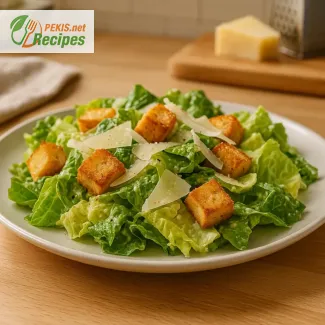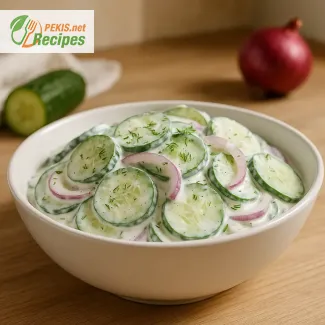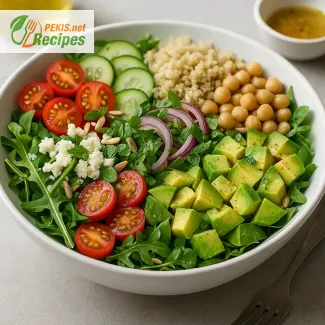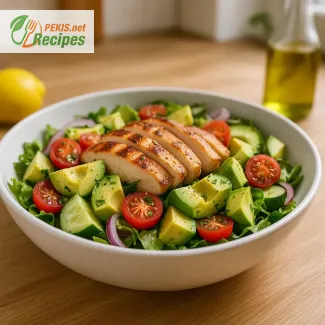
Fresh vegetable ribbons for vibrant summer meals
Discover how carrot ribbons can transform your salad into a culinary statement
When it comes to refreshing, colorful dishes that stand out both visually and in taste, carrot ribbon salad rises to the top. This playful and elegant dish celebrates the natural sweetness and crunch of fresh carrots, transformed into thin, silky ribbons that bring both texture and beauty to the plate. Unlike traditional chopped or grated salads, these vegetable ribbons elevate presentation and offer a new way to experience everyday produce.
The growing popularity of ribbon salads reflects a desire for light yet satisfying meals, especially during the warmer months. Whether served as a standalone vegetarian dish, a light lunch, or a vibrant side for grilled meats, this salad fits seamlessly into any occasion. It also opens the door to endless customization — you can easily add zucchini ribbons, cucumber, radish, or even beetroot to create a multicolored medley of fresh flavors.
Why carrot ribbons are more than a visual trend
The art of slicing carrots into delicate strips may seem like a stylistic choice, but there’s more behind the technique. These long, thin ribbons allow dressings to coat the vegetable more evenly, ensuring every bite is flavorful. Additionally, the softened texture from marination or a quick blanch enhances the carrots’ natural taste, making them more enjoyable than raw chunks.
One of the greatest advantages of the carrot ribbon salad is its versatility. You can combine it with citrus-based dressings, Asian-inspired vinaigrettes, or classic Mediterranean flavors like olive oil, lemon, and herbs. Tossing the ribbons with toasted nuts, feta cheese, or fresh herbs like dill and parsley elevates it from a side salad to a fully rounded meal.
The visual and textural appeal of ribbon salads
Visually, the appeal of ribboned vegetables is unmatched. The long, flowing shapes create an almost floral aesthetic on the plate, ideal for entertaining guests or for those who eat with their eyes first. From a textural standpoint, ribbons strike a perfect balance between crunch and tenderness, making each forkful varied and interesting.
Using a vegetable peeler or mandoline ensures consistent thickness and an attractive curl. This simple method transforms everyday carrots into a gourmet experience with little effort. Beyond carrots, this approach works wonderfully with other vegetables as well — think zucchini ribbons with lemon vinaigrette, or cucumber ribbons tossed with mint and yogurt.
Perfect for modern healthy lifestyles
Today’s food lovers value meals that are quick, beautiful, and nourishing. The carrot ribbon salad checks all three boxes. It’s naturally low in calories, packed with fiber, and can be tailored to various dietary preferences including gluten-free, vegan, or dairy-free. This adaptability makes it a reliable choice for family gatherings, picnics, and clean eating routines.
Many home cooks are drawn to this recipe because it offers sophistication without complexity. In under 15 minutes, you can prepare a dish that looks restaurant-worthy. Add a tangy dressing, sprinkle with seeds or spices, and you've got a crowd-pleasing salad that feels as good as it looks.
Flavor combinations and creative pairings
While the base is simple — just ribbons of carrots — the beauty of this salad lies in how it can be elevated. Consider tossing the ribbons with a honey-lime vinaigrette, ginger soy dressing, or a tahini lemon sauce. Each brings out different dimensions of the carrots’ natural flavor.
For extra crunch, try adding sunflower seeds, pistachios, or sliced almonds. A sprinkle of goat cheese or crumbled feta introduces a creamy contrast, while fresh mint or basil offers a burst of freshness. You can even top it with grilled halloumi or tofu for a more substantial main course.
The ribbon format also plays well with fruits — thin slices of apple, mango, or pear add sweetness and balance the earthiness of the carrots. A touch of chili or black pepper enhances the complexity for those who enjoy a little heat.
Seasonal, shareable and endlessly customizable
Ribbon salads are particularly well-suited for seasonal entertaining. They bring a burst of color and sophistication to outdoor dining, yet require minimal ingredients and tools. Whether served at a picnic, barbecue, or brunch table, a carrot ribbon salad quickly becomes a centerpiece dish that encourages guests to take notice.
Because it's easily scalable, this salad works just as well for a solo lunch as it does for a large crowd. Double or triple the quantities and prepare in advance — the ribbons hold their shape beautifully and even benefit from short marination times, making them ideal for make-ahead menus.
From simple weeknight meals to festive summer spreads, this recipe offers a refreshing change of pace from ordinary salads. With its balance of aesthetics, nutrition, and ease, it’s no wonder the carrot ribbon salad is becoming a modern classic in kitchens worldwide.
- Peel the carrots using a vegetable peeler, then continue peeling to create long, thin carrot ribbons. Place the ribbons in a large mixing bowl.
- Prepare the dressing by whisking together olive oil, lemon juice, honey, Dijon mustard, salt, and black pepper in a small bowl until emulsified.
- Toss the carrot ribbons with the dressing gently to ensure they are evenly coated. Let sit for 5 minutes to soften slightly.
- Add chopped parsley, sunflower seeds, and crumbled feta to the bowl. Toss everything again just before serving.
- Serve chilled or at room temperature on a large platter or in individual bowls.
Creative upgrades for elevating your carrot ribbon salad
Smart ingredient swaps and flavor enhancements for a more refined version
Transforming a carrot ribbon salad into a culinary centerpiece is easier than it seems — with just a few thoughtful adjustments, this already vibrant dish can become more sophisticated, better balanced, and tailored to personal taste or dietary needs. Whether you're preparing it for a summer brunch, a weekday lunch, or a festive table, the key lies in experimenting with texture, acidity, and added complexity.
Enhancing the dressing for depth and balance
One of the simplest ways to improve this recipe is by modifying the dressing. While the classic lemon-honey-mustard combination offers brightness and sweetness, replacing honey with maple syrup or date syrup introduces a more earthy and rich tone. Adding a dash of apple cider vinegar or white balsamic vinegar brings another layer of acidity, which balances the natural sweetness of the carrots even better.
Incorporating a small amount of grated ginger or minced shallots adds subtle pungency and aromatic depth. For those who enjoy a spicy kick, a pinch of red pepper flakes or a few drops of sriracha can make the salad pop. These upgrades turn the dressing from a simple vinaigrette into a complex flavor base that coats the ribbons evenly.
Building on texture: crunch and creaminess
One of the appeals of carrot ribbons is their silky texture, which pairs beautifully with elements that contrast in mouthfeel. While sunflower seeds provide a pleasant crunch, adding toasted almonds, walnuts, or pistachios creates a more intense nutty profile. For an even more luxurious texture, crumbled goat cheese, ricotta salata, or even a light spoonful of Greek yogurt enhances creaminess and introduces a mild tang.
Adding cooked quinoa, chickpeas, or beluga lentils also turns the salad into a protein-rich meal, while keeping it plant-forward and nutritious. These components offer a dense bite that balances the lightness of the ribbons, making the dish more filling without being heavy.
Upgrading vegetables for more color and nutrients
Carrots are the star, but expanding the palette of ribboned vegetables increases both visual appeal and nutritional content. Zucchini, yellow squash, beetroot, or daikon radish make stunning additions. For a peppery note, watermelon radish or arugula ribbons work beautifully. Not only do these vegetables add color variation, but they also bring contrasting flavors that heighten the overall experience.
If using vegetables like beets, it's important to keep ribbons separate at first to prevent bleeding of color. Serving them layered or arranged on the plate instead of tossed can result in a more artistic presentation.
Why homemade makes a difference
Preparing this salad at home allows control over every detail — from the thickness of the ribbons to the exact balance of the dressing. Commercial salads often use preservatives, pre-cut vegetables, or generic vinaigrettes, which dull the freshness and flavor integrity.
At home, you can use organic carrots, adjust the sweetness, salt, or acidity to your preference, and serve it immediately after preparation for maximum crunch and vibrancy. Using a sharp vegetable peeler or mandoline ensures consistency in slice thickness, which directly affects texture and how well the ribbons absorb dressing.
Common mistakes and how to avoid them
A frequent issue with ribbon salads is overdressing. Because ribbons are thin, they don’t absorb excess moisture well, which can lead to sogginess. A light toss is all that’s needed. It’s also important to let the dressed salad rest briefly — about five minutes — so the flavors meld and the carrots soften slightly without becoming limp.
Another mistake is using large, fibrous carrots that produce dry, brittle ribbons. Opt for medium-sized, firm carrots with a smooth surface. Wash thoroughly and peel gently to avoid wastage and maintain integrity.
For those new to slicing ribbons, applying even pressure with the peeler and rotating the carrot after each strip helps produce even results. Ribbons that are too thick won’t bend properly, and those that are too thin might break.
Health-forward adjustments and cleaner versions
To make the dish more suitable for special diets, several substitutions can be made without compromising flavor. Replace feta cheese with crumbled tofu, plant-based feta, or nut cheese for a dairy-free version. Use agave nectar instead of honey for a fully vegan adaptation.
If you wish to lower sodium intake, skip the cheese and reduce added salt — the natural flavors of the vegetables and herbs will still shine through. For a more antioxidant-rich version, use purple carrots, which contain anthocyanins, or add finely chopped fresh basil, which offers anti-inflammatory properties.
Including herbs like mint, cilantro, or chives adds not only fresh flavor but boosts the salad’s nutritional value. These herbs bring additional vitamins and contribute to better digestion and metabolic function.
Ingredient synergy and flavor pairings
A well-composed salad thrives on contrast and complement. Sweet carrots go well with salty cheeses, acidic dressings, and nutty toppings. Introducing fruit elements like orange segments, pomegranate seeds, or thin apple slices adds brightness and contrast. For added umami, a sprinkle of nutritional yeast or a few capers can do wonders.
For serving, the salad pairs beautifully with grilled fish, herb-marinated tofu, or even roasted chicken, depending on dietary preferences. It also complements sourdough bread, couscous, or flatbreads as a complete meal spread.
This recipe can be adapted for various cultural palettes too. Incorporate sesame oil, soy sauce, and scallions for an Asian twist, or try oregano, lemon zest, and kalamata olives for a Mediterranean version. These global variations allow for personalization while preserving the heart of the original concept.
Allergens present in the recipe:
- Milk (feta cheese)
- Mustard (Dijon mustard)
- Seeds (sunflower seeds)
Contains gluten: No
Suggestions to eliminate allergens and gluten:
- Replace feta cheese with plant-based cheese to avoid milk allergens
- Omit or substitute Dijon mustard with a mustard-free vinaigrette to avoid mustard allergens
- Use pumpkin seeds or omit seeds entirely if allergic to sunflower seeds
Vitamins and minerals per serving (approximate):
- Vitamin A – 8,400 µg: Supports vision, immune system, and skin health
- Vitamin C – 10 mg: Enhances immune defense and collagen synthesis
- Vitamin K1 – 15 µg: Contributes to normal blood clotting
- Potassium – 400 mg: Regulates fluid balance and nerve signals
- Calcium – 75 mg: Strengthens bones and supports muscle function
- Magnesium – 35 mg: Supports muscle relaxation and energy production
- Folate (B9) – 25 µg: Vital for cell growth and DNA synthesis
Antioxidants per serving (approximate):
- Beta-carotene – 7,500 µg: Converted into vitamin A, supports eye health and immune function
- Lutein – 250 µg: Supports eye health and may reduce risk of macular degeneration
- Flavonoids – 50 mg: May reduce inflammation and support cardiovascular health





